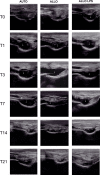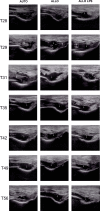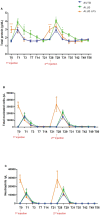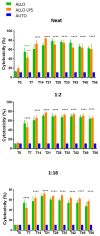Production of Cytotoxic Antibodies After Intra-Articular Injection of Allogeneic Synovial Membrane Mesenchymal Stem Cells With and Without LPS Administration
- PMID: 35572507
- PMCID: PMC9091817
- DOI: 10.3389/fimmu.2022.871216
Production of Cytotoxic Antibodies After Intra-Articular Injection of Allogeneic Synovial Membrane Mesenchymal Stem Cells With and Without LPS Administration
Abstract
Allogeneic mesenchymal stem cells (MSC) are widely used in clinical routine due to the shorter expansion time and reliability of its quality. However, some recipients can produce alloantibodies that recognize MSCs and activate the immune system, resulting in cell death. Although antibody production was already described after MSC injection, no previous studies described the immune response after intra-articular MSC injection in acute synovitis. This study aimed to evaluate the influence of inflammation on immune response after single and repeated intra-articular injections of synovial membrane MSC (SMMSC). Horses were divided in three groups: control group (AUTO) received autologous synovial membrane MSCs; whereas group two (ALLO) received allogeneic SMMSCs and group three (ALLO LPS) was submitted to acute experimental synovitis 8 h before SMMSCs injection. The procedure was repeated for all groups for 28 days. Physical and lameness evaluations and synovial fluid analysis were performed. Sera from all animals were obtained before and every 7 days after each injection up to 4 weeks, to perform microcytotoxicity assays incubating donor SMMSCs with recipients' sera. The first injection caused a mild and transient synovitis in all groups, becoming more evident and longer in ALLO and ALLO LPS groups after the second injection. Microcytotoxicity assays revealed significant antibody production as soon as 7 days after SMMSC injection in ALLO and ALLO LPS groups, and cytotoxicity scores of both groups showed no differences at any time point, being equally different from AUTO group. Although inflammation is capable of inducing MHC expression in MSCs, which enhances immune recognition, cytotoxicity scores were equally high in ALLO and ALLO LPS groups, making it difficult to determine the potentiation effect of inflammation on antibody production. Our findings suggest that inflammation does not display a pivotal role in immune recognition on first allogeneic MSC injection. In a translational way, since specific antibodies were produced against MSCs, patients that need more than one MSC injection may benefit from a first allogeneic injection followed by subsequent autologous injections.
Keywords: MHC; cell rejection reactions; horses; humoral immune response; intraarticular injection; mesenchymal stromal cells; microcytotoxicity.
Copyright © 2022 Rosa, Krieck, Padula, Stievani, Rossi, Pfeifer, Basso, Braz, Golim and Alves.
Conflict of interest statement
The authors declare that the research was conducted in the absence of any commercial or financial relationships that could be construed as a potential conflict of interest.
Figures









References
-
- Joswig AJ, Mitchell A, Cummings KJ, Levine GJ, Gregory CA, Smith R 3rd, et al. Repeated Intra-Articular Injection of Allogeneic Mesenchymal Stem Cells Causes an Adverse Response Compared to Autologous Cells in the Equine Model. Stem Cell Res Ther (2017) 8:42. doi: 10.1186/s13287-017-0503-8 - DOI - PMC - PubMed
Publication types
MeSH terms
Substances
LinkOut - more resources
Full Text Sources
Research Materials

